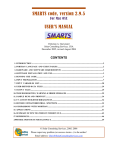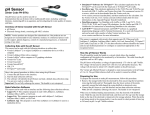Download UVA Sensor
Transcript
UVA Sensor (Order Codes UVA-BTA) The UVA Sensor is an ultraviolet light sensor that responds primarily to UVA radiation (approx. 320 to 390 nm). The UVA sensor is recommended for experiments that use a UV lamp. The UVA sensor includes a built-in light diffuser to make the readings somewhat less sensitive to the orientation of the sensor. Collecting Data with the UVA Sensor This sensor can be used with the following interfaces to collect data: Vernier LabQuest® 2 or the original LabQuest® as a standalone device or with a computer Vernier LabQuest® Mini with a computer Vernier LabPro® with a computer or TI graphing calculator Vernier Go!®Link with a computer Vernier EasyLink® with a TI-84 Plus calculator or TI-Nspire handheld Vernier SensorDAQ® with a computer CBL 2™ with a TI graphing calculator TI-Nspire™ Lab Cradle with TI-Nspire technology Here is the general procedure to follow when using the UVA Sensor: 1. Connect the UVA Sensor to the interface. 2. Start the data-collection software. 3. The software will identify the UVA Sensor and load a default data-collection setup. You are now ready to collect data. Data-Collection Software This sensor can be used with an interface and the following data-collection software. Logger Pro 3 This computer program is used with LabQuest 2, LabQuest, LabQuest Mini, LabPro, or Go!Link Logger Lite This computer program is used with LabQuest 2, LabQuest, LabQuest Mini, LabPro, or Go!Link LabQuest App This program is used when LabQuest 2 or LabQuest is used as a standalone device. EasyData App This calculator application for the TI-83 Plus and TI-84 Plus can be used with CBL 2, LabPro, and Vernier EasyLink. DataMate program This calculator program for the TI-73, TI-83, TI-84, TI-86, TI-89, and Voyage 200 calculators can be used with CBL 2 and LabPro. DataQuest™ Software for TI-Nspire™ This calculator application for the TI-Nspire can be used with the EasyLink or TI-Nspire Lab Cradle. LabVIEW™ National Instruments LabVIEW™ software is a graphical programming language sold by National Instruments. It is used with SensorDAQ and can be used with a number of other Vernier interfaces. See www.vernier.com/labview for more information. NOTE: Vernier products are designed for educational use. Our products are not designed nor recommended for any industrial, medical, or commercial process such as life support, patient diagnosis, control of a manufacturing process, or industrial testing of any kind. Specifications UV peak sensitivity: Wavelength sensitivity region, approximate: one volt per 3940 mW/m² at 340 nm 320 to 390 nm (320 to 375 nm, halfsensitivity points) See graphs for more detail. 2.5 mW/m² 13-bit resolution (SensorDAQ): 12-bit resolution (LabPro, LabQuest 2, LabQuest, LabQuest Mini, Go!Link, EasyLink, TI-Nspire™ Lab Cradle): 10-bit resolution (CBL 2™): Dimensions: Time response: Stored calibration 5 mW/m² 20 mW/m² 21 cm by 2 cm diameter approximately 2 seconds to reach 95% of final reading 3940 mW/(m² V) 0 Vout * 3940 mW/(m² V) slope (gain): intercept (offset): Irradiance: This sensor is equipped with circuitry that supports auto-ID. When used with LabQuest 2, LabQuest, LabQuest Mini, LabPro, Go!Link, SensorDAQ, TI-Nspire™ Lab Cradle, EasyLink, or CBL 2™, the data-collection software identifies the sensor and uses pre-defined parameters to configure an experiment appropriate to the recognized sensor. How the UVA Sensor Works The Vernier UVA Sensor is built around a broadband UV sensitive silicon photodiode. The diode produces a current proportional to the UV intensity. A wavelength selective filter limits light striking the diode to only the UVA region. The signal from the diode is amplified and sent to the output. Optional Calibration Procedure You do not have to perform a new calibration when using the UVA Sensor. You can use the appropriate calibration file that is stored in your data-collection program from Vernier or on the sensor itself. It is quite difficult to calibrate a UV sensor to read in absolute units, since you must have a source of known UV intensity and spectral distribution. More often you will simply want to calibrate the sensor in terms of a relative intensity. In that case, you 2 will point the sensor at a UV source (most often the sun) and define that intensity as 100%. To perform this kind of calibration, complete the following steps for a twopoint calibration. One of the points is your zero, with no light striking the sensor. Cover the tip of the UVA Sensor with a clean opaque object. Select the calibration option of the program you are using. Enter 0 (zero) as the first known intensity. Now allow full UV intensity to strike the sensor. Since the orientation of the sensor affects the reading, it is best to hold the sensor in place with a ring stand or other clamp. To point the sensor directly at the sun, make the shadow of the sensor tube as small as possible. Enter 100 as the next known intensity. Subsequent measurements will be relative to this second intensity. Note that you cannot calibrate a light sensor using a broadband light source (such as a lamp or the sun) against another light sensor of known calibration, unless the spectral response of the two sensors is exactly the same. Similarly, any intensity measurements of a broadband source using two sensors with different spectral response cannot be directly compared. For example, a reading from another manufacturer’s UVA Sensor would not correspond to the readings from the Vernier UVA Sensor. In all these cases a direct comparison is not appropriate, since the reading from any light sensor is a convolution of the spectral distribution of the incident light and the spectral response of the sensor. with the forecast, some UV sensors can be calibrated in terms of UV Index. Since the UV Index includes a wavelength weighting corresponding to the erythemal action spectrum, only sensors matching the erythemal spectrum can logically be calibrated in terms of UV Index. An erythemally-weighted irradiance measurement of 0.25 mW/cm² corresponds to a UV Index of 10. Since the Vernier UVA and UVB Sensors allow the separate measurement of UVA and UVB irradiance (instead of an erythemally weighted average) the individual readings of the Vernier sensors cannot strictly be converted to UV Index units. The erythemal action spectrum is predominately UVB, so the UVA Sensor reading cannot be used to estimate UV index. UV Terminology References The Vernier UVA and UVB (Order code UVB-BTA) Sensors responds to specific regions of the electromagnetic spectrum. The wavelength region from 320 to 400 nm is commonly called UVA radiation, and 280 to 320 nm is called UVB radiation. Wavelengths shorter than 280 nm fall into the UVC spectrum. Neither Vernier sensor is sensitive to UVC radiation. Plants and animals respond differently to the three types of UV radiation. Although very harmful to plants and animals, UVC radiation is nearly completely absorbed by the ozone in the Earth’s atmosphere. Some UVB radiation makes it through the atmosphere, although the degree of absorption depends critically on the angle of the sun and the amount of ozone along the light path. UVB radiation is thought to be responsible for reddening of the skin (erythema), cataracts, and skin cancers. UVA can also cause these effects on human skin, but to a lesser extent. It is generally agreed that UVB radiation is the primary danger to humans, but increasingly UVA is being shown to cause delayed, but significant, damage to skin and eyes. The standard erythemal (or sunburning) action spectrum (McKinlay and Diffey, 1987) represents a combined estimate of the relative sensitivity of skin as a function of wavelength. Since knowledge of how UV light affects skin improves with time, the erythemal spectrum may not represent the latest thinking of UV danger. There are several ways of measuring UV light intensity and exposure. The usual irradiance unit for measurement is mW/cm², but a simplified UV Index system is also in use. The UV Index is actually a forecast, not a measurement. For comparison 3 Suggested Experiments 1. Measure the UV intensity as a function of time throughout the day. Do you need to worry about sunscreen at 8:00 in the morning? 2. Measure the UV transmittance of various sunglasses and regular glasses. Do your sunglasses protect your eyes from UVA? Can you get a sunburn through a car window? 3. Measure the UV transmittance of fabrics, both wet and dry. Does a wet tee-shirt provide much solar protection? 1. McKinlay, A. F., and B. L. Diffey, 1987: A reference spectrum for ultraviolet- induced erythema in human skin. Human Exposure to Ultraviolet Radiation: Risks and Regulations. W. F. Passchier and B. F. Bosnajakovic, eds., Elsevier, 83–87. Warranty Vernier warrants this product to be free from defects in materials and workmanship for a period of five years from the date of shipment to the customer. This warranty does not cover damage to the product caused by abuse or improper use. Vernier Software & Technology 13979 S.W. Millikan Way Beaverton, OR 97005-2886 Toll Free (888) 837-6437 (503) 277-2299 FAX (503) 277-2440 [email protected] www.vernier.com Rev 6/5/2012 Logger Pro, Logger Lite, Vernier LabQuest 2, LabQuest, Vernier LabPro, Go! Link, Vernier EasyLink and other marks shown are our trademarks or registered trademarks in the United States. TI-Nspire, CBL 2 and CBL, TI-GRAPH LINK, and TI Connect are trademarks of Texas Instruments. All other marks not owned by us that appear herein are the property of their respective owners, who may or may not be affiliated with, connected to, or sponsored by us. Printed on recycled paper. 4









